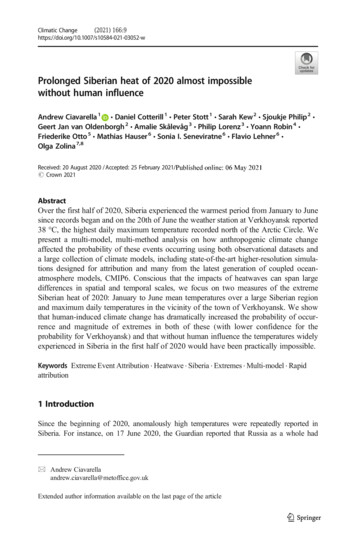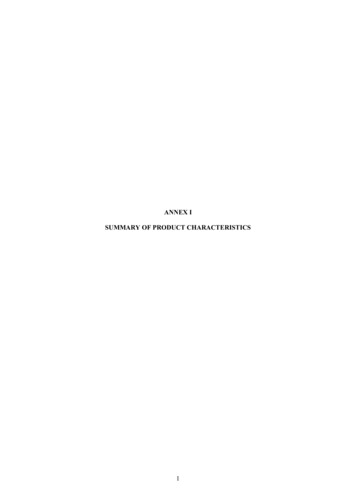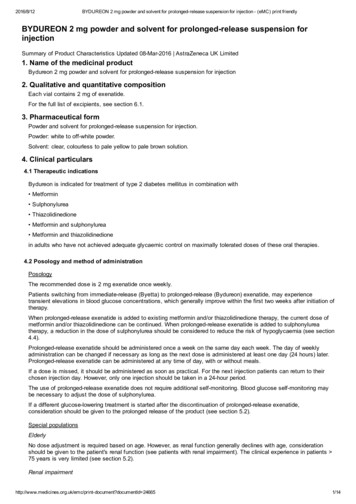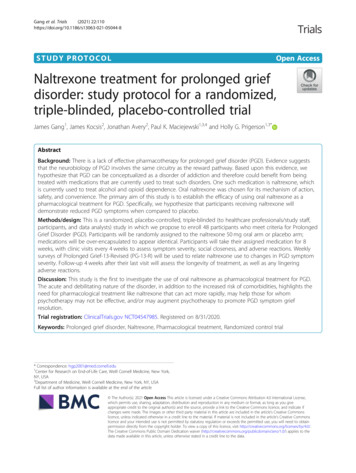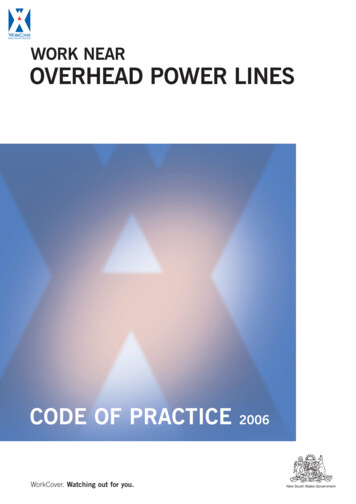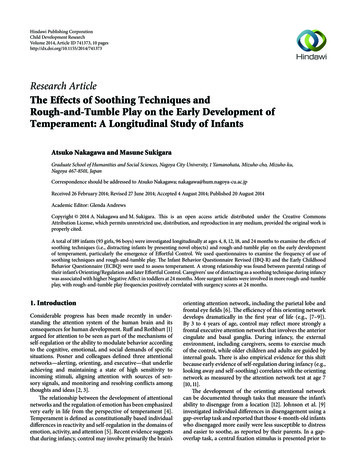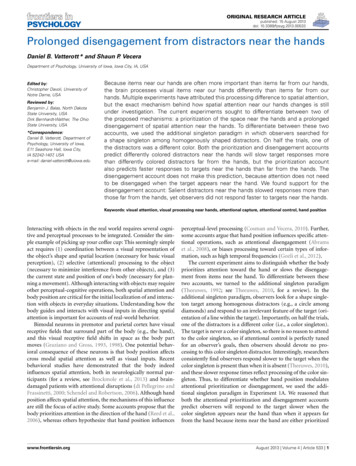
Transcription
ORIGINAL RESEARCH ARTICLEpublished: 15 August 2013doi: 10.3389/fpsyg.2013.00533Prolonged disengagement from distractors near the handsDaniel B. Vatterott * and Shaun P. VeceraDepartment of Psychology, University of Iowa, Iowa City, IA, USAEdited by:Christopher Davoli, University ofNotre Dame, USAReviewed by:Benjamin J. Balas, North DakotaState University, USADirk Bernhardt-Walther, The OhioState University, USA*Correspondence:Daniel B. Vatterott, Department ofPsychology, University of Iowa,E11 Seashore Hall, Iowa City,IA 52242-1407, USAe-mail: daniel-vatterott@uiowa.eduBecause items near our hands are often more important than items far from our hands,the brain processes visual items near our hands differently than items far from ourhands. Multiple experiments have attributed this processing difference to spatial attention,but the exact mechanism behind how spatial attention near our hands changes is stillunder investigation. The current experiments sought to differentiate between two ofthe proposed mechanisms: a prioritization of the space near the hands and a prolongeddisengagement of spatial attention near the hands. To differentiate between these twoaccounts, we used the additional singleton paradigm in which observers searched fora shape singleton among homogenously shaped distractors. On half the trials, one ofthe distractors was a different color. Both the prioritization and disengagement accountspredict differently colored distractors near the hands will slow target responses morethan differently colored distractors far from the hands, but the prioritization accountalso predicts faster responses to targets near the hands than far from the hands. Thedisengagement account does not make this prediction, because attention does not needto be disengaged when the target appears near the hand. We found support for thedisengagement account: Salient distractors near the hands slowed responses more thanthose far from the hands, yet observers did not respond faster to targets near the hands.Keywords: visual attention, visual processing near hands, attentional capture, attentional control, hand positionInteracting with objects in the real world requires several cognitive and perceptual processes to be integrated. Consider the simple example of picking up your coffee cup: This seemingly simpleact requires (1) coordination between a visual representation ofthe object’s shape and spatial location (necessary for basic visualperception), (2) selective (attentional) processing to the object(necessary to minimize interference from other objects), and (3)the current state and position of one’s body (necessary for planning a movement). Although interacting with objects may requireother perceptual-cognitive operations, both spatial attention andbody position are critical for the initial localization of and interaction with objects in everyday situations. Understanding how thebody guides and interacts with visual inputs in directing spatialattention is important for accounts of real-world behavior.Bimodal neurons in premotor and parietal cortex have visualreceptive fields that surround part of the body (e.g., the hand),and this visual receptive field shifts in space as the body partmoves (Graziano and Gross, 1993, 1998). One potential behavioral consequence of these neurons is that body position affectscross modal spatial attention as well as visual inputs. Recentbehavioral studies have demonstrated that the body indeedinfluences spatial attention, both in neurologically normal participants (for a review, see Brockmole et al., 2013) and braindamaged patients with attentional disruptions (di Pellegrino andFrassinetti, 2000; Schendel and Robertson, 2006). Although handposition affects spatial attention, the mechanisms of this influenceare still the focus of active study. Some accounts propose that thebody prioritizes attention in the direction of the hand (Reed et al.,2006), whereas others hypothesize that hand position influenceswww.frontiersin.orgperceptual-level processing (Cosman and Vecera, 2010). Further,some accounts argue that hand position influences specific attentional operations, such as attentional disengagement (Abramset al., 2008), or biases processing toward certain types of information, such as high temporal frequencies (Gozli et al., 2012).The current experiment aims to distinguish whether the bodyprioritizes attention toward the hand or slows the disengagement from items near the hand. To differentiate between thesetwo accounts, we turned to the additional singleton paradigm(Theeuwes, 1992; see Theeuwes, 2010, for a review). In theadditional singleton paradigm, observers look for a shape singleton target among homogenous distractors (e.g., a circle amongdiamonds) and respond to an irrelevant feature of the target (orientation of a line within the target). Importantly, on half the trials,one of the distractors is a different color (i.e., a color singleton).The target is never a color singleton, so there is no reason to attendto the color singleton, so if attentional control is perfectly tunedfor an observer’s goals, then observers should devote no processing to this color singleton distractor. Interestingly, researchersconsistently find observers respond slower to the target when thecolor singleton is present than when it is absent (Theeuwes, 2010),and these slower response times reflect processing of the color singleton. Thus, to differentiate whether hand position modulatesattentional prioritization or disengagement, we used the additional singleton paradigm in Experiment 1A. We reasoned thatboth the attentional prioritization and disengagement accountspredict observers will respond to the target slower when thecolor singleton appears near the hand than when it appears farfrom the hand because items near the hand are either prioritizedAugust 2013 Volume 4 Article 533 1
Vatterott and Veceraor disengagement from these items is prolonged. Critically, theattentional prioritization account also predicts that because thespace near the hands is prioritized, observers will respond fasterto targets near the hands than far, but the disengagement accountdoes not make this prediction.It is possible hand position will have a small effect on task performance because the additional singleton paradigm traditionallyuses consistently defined target and distractors, which encourages observers to guide attention based on the task features (Lamyet al., 2006). That is, observers might rely on a well-learned target template for the circle target, thereby minimizing the hand’soverall influence. Thus, to fully evaluate the target prioritizationaccount, it is critical to prevent attentional guidance by features.To discourage observers from guiding search based on target anddistractor features, we used the mixed version of the additionalsingleton paradigm in Experiment 1B (Pinto et al., 2005). In thisversion of the task, the target/distractor identities and object colors change from trial to trial. For example, on one trial, the targetcould be defined as a circle among diamonds and on the nextit could be a diamond among circles. Additionally, the color ofthe target changes from trial to trial. These changes minimizethe opportunity for observers to guide attention based on a target template (i.e., a specific shape or color feature) other than asingleton search mode (Pashler, 1988).To investigate whether attention is prioritized near the handsor attention is slower to disengage from items near the hands,half the observers completed the additional singleton paradigmwith either their left or right hand near the screen. The otherhalf of participants completed the mixed version of the additionalsingleton paradigm with either their left or right hand near thescreen. Slower responses to the target when the color singletonwas near the hand than far from the hand will serve as a manipulation check because both accounts predict this. Critically, ifattention is prioritized to items near the hands, then observersshould be faster to respond to targets near the hands than far, butif observers are slower to disengage from items near the hands,then observers will not respond faster to items near the handsthan far.METHODSOBSERVERSThirty-two undergraduate students from the University of Iowaparticipated to fulfill a course requirement. Sixteen participatedin Experiment 1A and sixteen participated in Experiment 1B. Allobservers reported normal or corrected-to-normal vision.STIMULI AND PROCEDUREA Mac Mini computer with a 17-in CRT monitor presentedstimuli and collected response through MATLAB and thePsychophysics Toolbox (Brainard, 1997). Eight stimuli were presented around an imaginary circle centered on the screen with aradius of 6 . The stimuli consisted of seven diamonds and onecircle. The stimuli were each approximately 2.8 2.8 . Each itemcontained either a gray vertical or horizontal line. The lines measured 1.5 0.3 . In Experiment 1A, all the items were green (RGB20 210 5) except on half the trials, one of the diamonds was red(RGB 255 0 0). In Experiment 1B, the color (red or green) andFrontiers in Psychology Perception ScienceAttentional capture and hand positionshape (circle or diamond) of the target was chosen randomlyon each trial. A white fixation dot was presented at the centerof the screen and measured 0.6 0.6 . Additionally, two whitedots (0.6 0.6 ) were presented on the left and right sides of thescreen. These dots indicated where observers’ hands should placetheir hands.The target appeared equally often at any of the eight possible target positions. Observers responded to the orientation ofthe gray line within the target. Observers responded with a leftpedal if the target contained a vertical line and they respondedwith a right foot pedal if the target contained a horizontal line.Half the trials contained a target with a horizontal line and halfthe trials contained a target with a vertical line. A color singleton distractor was present on half the trials. The color singletondistractor appeared randomly at one of the seven positions notalready occupied by the target.On half the blocks the observers held their right hand up withtheir middle finger abutting the monitor. The palm of their handfaced toward the search array. On the other half of the blocks,observers held their left hand near the monitor. Observers’ armswere supported by armrests to prevent fatigue. The order of whichhand was initially held up to the monitor was counterbalancedacross observers. The blocks were 28 trials long and each experimental session consisted of 896 trials. Observers were given aself-paced break at the end of each block. Finally, to keep the displays as visually balanced as possible, a visual anchor abutting themonitor was always presented opposite to the raised hand.Each trial started with the presentation of a fixation dot andthe two dots indicating hand placement for a second. Followingthis, the search array was presented for 3 s or until response(see Figure 1). If observers took more than 3 s to respond, thetrial was scored as incorrect and observers were encouraged torespond faster. Observers were instructed to maintain fixationand to respond as quickly and accurately as possible. Observerscompleted four practice blocks of trials (two with each hand up)before the experimental session.RESULTS AND DISCUSSIONIncorrect responses and RTs more than 2.5 standard deviationsfrom an observers’ condition mean were excluded from the analysis. This eliminated 1.6% of the data in Experiment 1A and1.1% of the data in Experiment 1B. We submitted mean RTs toa mixed ANOVA with the within subject factors item near hand(Target or Distractor) and distance from hand (Near or Far).Experiment (1A or 1B) was a between subjects factor. To prevent any interference due to target and color singleton proximity(Mounts, 2000a,b), RTs in this analysis only included trials inwhich the target was present at one of the two positions on thevertical meridian and the color singleton was present in one ofthe two positions on the horizontal meridian when evaluating theeffect of hand position on distractor processing and vice versawhen evaluating the effect of hand position on target processing. Slower responses when the distractor was on the horizontalmeridian than when the target was on the horizontal meridiandrove a main effect of the item near hand factor, F(1, 30) 31.21,p 0.001. As expected, the item near hand factor interactedwith the experiment factor, F(1, 30) 15.05, p 0.001, because,August 2013 Volume 4 Article 533 2
Vatterott and VeceraFIGURE 1 Sequence of events for Experiments 1A,B. A fixation dotpreceded each search display by 1000-ms. The search display remained onthe screen for 3000-ms or until response. Color singletons appeared on50% of the trails. In (A) the color singleton appears on the horizontalmeridian near the hand and the target appears on the vertical meridian. In(B), the color singleton appears on the horizontal meridian far from thehand and the target appears on the vertical meridian.as depicted in Figures 2, 3, color singletons slowed responsesmore in Experiment 1B (mixed additional singleton design) thanin Experiment 1A (fixed additional singleton design). Observersresponded slower when the target or distractor appeared near thehand, F(1, 30) 3.83, p 0.06, demonstrating that the hand hadan effect. Slower responses to the target when the distractor isnear the hand than far from the hand (depicted in Figures 2, 3)likely drove this effect. The distance from the hand factor didnot interact with the experiment factor, F(1, 30) 0.65, p 0.42,demonstrating that the hand had the same effect in the twoexperiments.Interestingly, suggesting that the observers were slower torespond both when the target was near the hand and whenthe distractor was near the hand, the item near hand factor (target or distractor) and the distance from the handfactors did not interact, F(1, 30) 0.5, p 0.47. The threeway interaction between item near hand, distance from hand,and experiment also failed to reach significance, F(1, 30) 0.16, p 0.68. Although the non-significance of these interactions suggests hand position did not speed responses toitems near the target, because this is a central question of ourstudy, we conducted follow up analyses to investigate differences in RTs to targets near and far from the hands in eachexperiment.To evaluate the effect of hand position on target processing, we compared RTs when the target was on the horizontalmeridian and the distractor, when present, was on the verticalmeridian. Thus, we conducted a t-test comparing mean RTs totargets on the horizontal meridian near and far from the hand.Inconsistent with the prioritization account, in Experiment 1A,we found RTs to the target were no faster when the target wasnear the hand (765 ms) than far (758 ms), t(15) 0.60, p 0.55.www.frontiersin.orgAttentional capture and hand positionFIGURE 2 Experiment 1A response times (in ms) as a function of itemnear hand (target or distractor) and distance from hand (near the handor far from the hand). The error rates of each condition are reported in thebase of the bars. Error bars represent 95% within-subject confidenceintervals (Loftus and Masson, 1994).FIGURE 3 Experiment 1B response times (in ms) as a function of itemnear hand (target or distractor) and distance from hand (near the handor far from the hand). The error rates of each condition are reported in thebase of the bars. Error bars represent 95% within-subject confidenceintervals (Loftus and Masson, 1994).It is possible this t-test failed to find a difference because handposition has a different effect on target processing when the colorsingleton is present than absent, so we performed two additional t-tests on RTs from Experiment 1A, one comparing RTsto targets near and far from the hand when the color singleton was absent, t(15) 0.51, p 0.61, and another when thecolor singleton was present, t(15) 0.37, p 0.72. Thus, thesetests falsify the prioritization account and lend tentative support to the disengagement account of hand position’s effect oncognition.To evaluate if hand position affected responses to the target in Experiment 1B, we ran the same t-tests as in Experiment1A. Again, the results falsified the prioritization account sinceRTs to the target did not differ when the color singleton wasnear (1097 ms) and far from the hand (1110 ms), t(15) 0.87,p 0.4. Again, responses to targets near and far from the handAugust 2013 Volume 4 Article 533 3
Vatterott and VeceraAttentional capture and hand positiondid not depend on the presence or absence of the color singletonbecause these t-tests also failed to reach significance [Absent:t(15) 0.004, p 0.99; Present: t(15) 0.76, p 0.45]. Thus,our experiments demonstrate that observers were no faster torespond to targets near their hands, which is inconsistent withan attentional prioritization of items near the hand account andlends tentative support to the slowed disengagement from itemsnear the hands account.We repeated all RTs analyses with arcsine-transformed errorrates. The mixed ANOVA and planned follow-up comparisonsall failed to reach significance. We suspect these comparisons failed to reach significance because accuracy valueswere so close to ceiling. Importantly, the lack of significant values also demonstrates that the RT differences inthis experiment cannot be explained by a speed accuracytrade-off.GENERAL DISCUSSIONThe mechanism behind hand position’s effect on visual attentionis an open question and the current experiment sought to differentiate between the prioritization of items near the hands(Reed et al., 2006) and prolonged disengagement from itemsnear the hands accounts (Abrams et al., 2008). To differentiate between these accounts, we used the additional singleton paradigm because both accounts predicted greater slowingfrom color singletons near the hands than far from the hands.Importantly, the prioritization account predicts faster responsesto targets near the hands while the disengagement account doesnot. We rejected the prioritization account and we tentatively support the disengagement account because neither experiment 1Anor experiment 1B found faster responses to targets near than farfrom the hands while the two experiments did find slower RTswhen a distractor or target appeared near the hands than far fromthe hands.Our experiments did not seek to evaluate the perceptual-levelprocessing (Cosman and Vecera, 2010) and bias toward high temporal frequency accounts of hand position (Gozli et al., 2012).These accounts are still plausible especially since it is reasonableto speculate that hand position has multiple different effects alongthe processing stream. Future experiments should evaluate thesedifferent accounts of the mechanism behind hand position effects.One additional explanation of our data is that the colorsingleton distractors slowed response times not because they captured attention, but because color singletons require more preattentional processing (i.e., a filtering cost; Folk and Remington,1998). For instance, it is possible that items near the hand takelonger to process than items far from the hands, but we find thisREFERENCESAbrams, R. A., Davoli, C. C., Feng,D., Knapp, W. H. III., and Paul,D. (2008). Altered vision near thehands. Cognition 107, inard, D. H. (1997). The psychophysics toolbox. Spat. ole, J. R., Davoli, C. C.,Abrams, R. A., and Witt, J. K.(2013). The world within reach:effects of hand posture and tool-useon visual cognition. Curr. Dir.Psychol. Sci. 22, 38–44. doi: 10.1177/0963721412465065Frontiers in Psychology Perception Sciencehypothesis unlikely for a number of reasons. First, ERP evidencesupports the attentional capture account of the additional singleton paradigm (Hickey et al., 2006). Second, we believe it isunlikely the cognitive system is designed to process items near thehands slower than items far from the hands because items near thehands are likely important, and, if anything, should be processedfaster.One interesting question is why Reed et al. (2006) foundfaster detection of targets near the hands, but we did not findfaster responses to targets near the hands. It is possible that handposition is simply weighted like any other input to the attentional mechanism (Wolfe, 1994) and that when feature values areimportant, feature values are more heavily weighted and handposition is less weighted. Thus, in an experiment like Reed andcolleagues’ it is possible that the sparse displays provided so littleinformation that hand position was more heavily weighted (i.e.,prioritized). Basically, we propose that whether the space near thehands is prioritized may interact with the amount of informationobservers have to complete the rest of the task. When observershave little information to help them complete a task, such as ina Posner cuing task, the space near the hands is prioritized, butwhen observers are able to guide task performance with information such as target features, the space near the hands is notprioritized. We are currently running experiments to evaluate thispossibility.Because of hand position’s importance to many daily activities,spatial attention changes near the hands. The current experimentssought to evaluate between two accounts of exactly how spatialattention changes near the hands. The first account is that thespace near the hands is prioritized and the second account is thatobservers are slower to disengage from items appearing near theirhands. We failed to find support for the prioritization account, sowe tentatively support the disengagement account that observersare slower to disengage from items near their hands. Thus, ourexperiments suggest that the hands might not always change theprocessing of items near the hands and instead hand positionmight extend the processing of these potentially important items.ACKNOWLEDGMENTSThis research was supported in part by grants from the NationalScience Foundation (BCS 11-51209), the National Institutes ofHealth (R01AG026027), and by research contracts from theNissan Motor Corporation and the Toyota Motor Corporation.Correspondence should be addressed to either author atDepartment of Psychology, E11 Seashore Hall, University of Iowa,Iowa City, IA 52242-1407. Electronic mail can be sent to danielvatterott@uiowa.edu or shaun-vecera@uiowa.edu.Cosman, J. D., and Vecera, S. P. (2010).Attention affects visual perceptualprocessing near the hand. Psychol.Sci. 21, 1254–1258. doi: 10.1177/0956797610380697di Pellegrino, G., and Frassinetti, F.(2000). Direct evidence from parietal extinction of enhancement ofvisual attention near a visible hand.Curr. Biol. 10, 1475–1477. doi:10.1016/S0960-9822(00)00809-5Folk, C. L., and Remington, R. W.(1998). Selectivity in distraction byirrelevant featural singletons: evidence for two forms of attentional capture. J. Exp. Psychol. Hum.Percept. Perform. 24, 847–858. doi:10.1037/0096-1523.24.3.847August 2013 Volume 4 Article 533 4
Vatterott and VeceraGozli, D. G., West, G. L., and Pratt, J.(2012). Hand position alters visionby biasing processing throughdifferent visual pathways. Cognition124, 244–250. doi: 10.1016/j.cognition.2012.04.008Graziano, M. S. A., and Gross, C. G.(1993). A bimodal map of space:somatosensory receptive fields inthe macaque putamen with corresponding visual receptive fields.Exp. Brain Res. 97, 96–109. doi:10.1007/BF00228820Graziano, M. S., and Gross, C. G.(1998). Spatial maps for the control of movement. Curr. Opin.Neurobiol. 8, 195–201. doi: 10.1016/S0959-4388(98)80140-2Hickey, C., McDonald, J. ceof the capture of visual attention.J. Cogn. Neurosci. 18, 604–613. doi:10.1162/jocn.2006.18.4.604Lamy, D., Carmel, T., Egeth, H. E.,and Leber, A. B. (2006). Effects ofsearch mode and intertribal priming on singleton search. Percept.www.frontiersin.orgAttentional capture and hand positionPsychophys. 68, 919–932. doi:10.3758/BF03193355Loftus, G. R., and Masson, M. E. J.(1994). Using confidence intervalsin within-subject designs. Psychon.Bull. Rev. 1, 476–490. doi: 10.3758/BF03210951Mounts, J. R. W. (2000a). Evidencefor suppressive mechanisms inattentional selection: feature singletons produce inhibitory surrounds.Percept. Psychophys. 62, 969–983.doi: 10.3758/BF03212082Mounts, J. R. W. (2000b). Attentionalcapture by abrupt onsets and feature singletons produces inhibitorysurrounds. Percept. Psychophys.62, 1485–1493. doi: 10.3758/BF03212148Pashler, H. (1988). Cross-dimensionalinteraction and texture segregation.Percept. Psychophys. 43, 307–318.doi: 10.3758/BF03208800Pinto, Y., Olivers, C. N. L., andTheeuwes, J. (2005). Target uncertainty does not lead to moredistraction by singletons: intertrialpriming does. Percept. Psychophys.67, 1354–1361. doi: 10.3758/BF03193640Reed, C. L., Grubb, J. D., and Steele,C. (2006). Hands up; attentionalprioritization of space near thehands. J. Exp. Psychol. Hum. Percept.Perform. 21, 166–177. doi: 10.1037/0096-1523.32.1.166Schendel, K., and Robertson, L. C.(2006). Reaching out to see: armposition can attenuate human visualloss. J. Cogn. Neurosci. 16, 935–943.doi: 10.1162/0898929041502698Theeuwes, J. (1992). Perceptual selectivity for color and form. Percept.Psychophys. 51, 599–606. doi:10.3758/BF03211656Theeuwes, J. (2010). Top-down andbottom-up control of visual selection. Acta Psychol. 123, 77–99. doi:10.1016/j.actpsy.2010.02.006Wolfe, J. M. (1994). Guided search 2.0a revised model of visual search.Psychon. Bull. Rev. 1, 202–238. doi:10.3758/BF03200774Conflict of Interest Statement: Theauthors declare that the researchwas conducted in the absence of anycommercial or financial relationshipsthat could be construed as a potentialconflict of interest.Received: 17 June 2013; accepted: 30 July2013; published online: 15 August 2013.Citation: Vatterott DB and VeceraSP (2013) Prolonged disengagementfrom distractors near the hands. Front.Psychol. 4:533. doi: 10.3389/fpsyg.2013.00533This article was submitted to Frontiersin Perception Science, a specialty ofFrontiers in Psychology.Copyright 2013 Vatterott andVecera. This is an open-access articledistributed under the terms of theCreative Commons Attribution License(CC BY). The use, distribution orreproduction in other forums is permitted, provided the original author(s)or licensor are credited and that theoriginal publication in this journalis cited, in accordance with acceptedacademic practice. No use, distributionor reproduction is permitted which doesnot comply with these terms.August 2013 Volume 4 Article 533 5
Daniel B. Vatterott, Department of Psychology, University of Iowa, E11 Seashore Hall, Iowa City, IA 52242-1407, USA e-mail: daniel-vatterott@uiowa.edu. Because items near our hands are often more important than items far from our hands, the brain processes visual items near our hands differently than items far from our hands.

